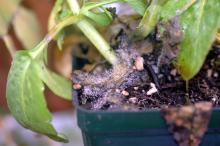See:
Greenhouse Plants, Ornamental - Gray Mold
Cause The fungus Botrytis cinerea is a common problem when old pansy flowers begin to decline. This fungus colonizes dead, dying, and wounded plant parts. From these infections they can attack healthy tissues. A moist, humid environment is ideal for pathogen sporulation and spread. Conidia may come from sources in and outside the greenhouse. It is found everywhere plants are grown and has a wide host range. Flower petals are most susceptible at any stage of development.
Symptoms A circular, water-soaked spot is first observed on the flower petals. This is quickly followed by tan to gray-brown blotches with fuzzy, gray growth. New leaves may have brown V-shaped lesions at the leaf margin. Plant tissues can appear discolored and fuzzy.
Cultural control
- Remove dead and dying foliage in and around the plants.
- Maintain a steady, relatively dry environment by keeping greenhouse humidity below 90%, increasing spacing between plants for good air circulation, and taking care not to splash water on foliage during watering. Heating the greenhouse at night (especially for zero or negative DIF) or venting around sunset may be necessary. Heating in the morning before sunup can also help prevent dew formation as air temperature increases faster than the temperature of plant parts. If using DROP or DIP for size control, do not let humidity rise above 90%.
- Space plants for good air circulation.
- Maintain high light levels and good air movement around the foliage.
- The use of calcium chloride prior to shipping plants has been helpful.
Chemical control Rotate fungicides with different modes of action to prevent the development of resistant organisms. Limit the use of any one group during crop production.
- Astun at 10 to 17 fl oz/100 gal water. Group 7 fungicide. 12-hr reentry.
- Broadform at 4 to 8 fl oz/100 gal water. Group 7 + 11 fungicide. 12-hr reentry.
- Chipco 26019 FLO at 1 to 2.5 quarts/100 gal water. Group 2 fungicide. 12-hr reentry.
- Daconil Weather Stik at 1.38 pints/100 gal water. Group M5 fungicide. 12-hr reentry.
- Decree 50 WDG at 0.75 to 1.5 lb/100 gal water. Group 17 fungicide. 12-hr reentry.
- Mancozeb-based products can be used as mixing partners and provide some protection. Group M3 fungicides. 24-hr reentry.
- Fore 80 WP at 1.5 lb/100 gal water plus a spreader-sticker.
- Protect DF at 1 to 2 lb/100 gal water plus 2 to 4 oz spreader-sticker.
- Medallion WDG at 2 to 4 oz/100 gal water. Using with oils or adjuvants may damage plant. Group 12 fungicide. 12-hr reentry.
- Orkestra at 8 fl oz/100 gal water. Group 7 + 11 fungicide. 12-hr reentry.
- Pageant at 12 to 18 oz/100 gal water. Do not use with organosilicone-based adjuvants. Group 7 + 11 fungicide. 12-hr reentry.
- Palladium at 4 to 6 oz/100 gal water. Avoid excessive runoff to small plants, which may result in stunting and/or chlorosis. Group 9 + 12 fungicide. 12-hr reentry.
- Phyton 27 at 1.3 to 2 oz/10 gal water. Group M1 fungicide. 48-hr reentry.
- Sil-Matrix at 1 to 4 quarts/100 gal water plus a nonionic surfactant. Do not use on open blooms. 4-hr reentry. O
- Spirato GHN at 2 to 4 fl oz/100 gal water. Use with oils or adjuvants may cause plant damage. Group 12 fungicide. 12-hr reentry.
- Terraguard SC at 4 to 8 fl oz/100 gal water. Group 3 fungicide. 12-hr reentry.
Biological control
- BotryStop (Urocladium oudemansii U3 strain) at 2 to 4 lb/A. Keep refrigerated before use. Compatible with many wetting agents, some fungicides, and biologicals but not all. Unknown efficacy in the PNW. 4-hr reentry. O
Reference Rivera, M.C., and Lopez, S.E. 2004. First report of Botrytis cinerea on pansy flowers in Buenos Aires. Plant Disease 88:1164-1164.


